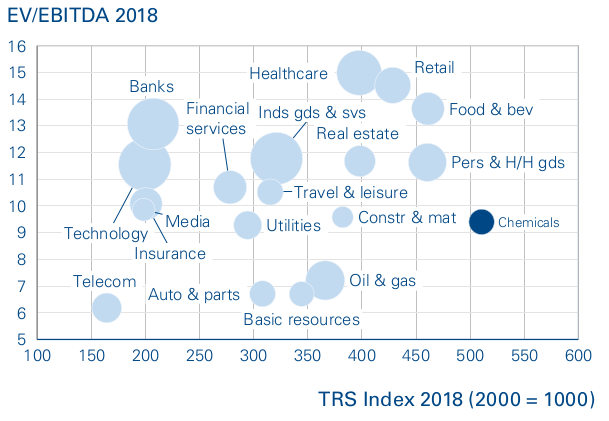DATE
2 min read • Chemicals, Information management
Breaking the mold
Unleashing the power of convergence in the chemical industry


Unknown to many, the chemical industry has been one of the most successful sectors in terms of historic value creation for its shareholders in the last 20 years. Investors however have not seemed to be that impressed, as evidenced by the industry’s underwhelming estimated future potential (measured as average EV/EBITDA multiples for chemical companies).
Exhibit: Industry valuations as enterprise value over EBITDA (2018) versus performance as total return to shareholders (data from 2000–2018).

Chemical firms are starting to understand that this matters not just financially, but also strategically, because it adds greatly to the challenges that already make it difficult for any industrial company to transform its business, such as locked-in assets, long development times, and slow adoption of new technology.
Taken together, these challenges seem to suggest that it will be nearly impossible for most chemical firms to ever be more than suppliers of ingredients and components to the big-ticket solutions of tomorrow, let alone becoming co-orchestrators of these solutions, as many chemical companies aspire to.
This predicament is hardly new, but as we argue in our recent article on the topic, there are four important trends which, combined, may fundamentally change the rules of the game. These trends are 1) the rise of digital technology, 2) technology transfer from other industries, 3) new management approaches and 4) the deployment of radically new business models. Whenever these trends converge at the right times and places to address mankind’s “mega-needs”, they can act as powerful enablers and bring to the chemical industry what the internet, cheap computing power and agile software development have brought to so many other industries.
To make this happen, business leaders need to understand how all the pieces of the puzzle fit together and be prepared to make decisions surrounded by more ambiguity and uncertainty than they are used to. And it will not be enough for chemical firms to change the way they navigate and leverage technology convergence. They must also embrace a new style of communication with the outside world and internally, based on a compelling growth and innovation narrative which will serve to align investors, decision-makers and innovators around a specific and decisive innovation-based growth agenda in a converging world.
The full report is available upon request here
2 min read • Chemicals, Information management
Breaking the mold
Unleashing the power of convergence in the chemical industry

DATE

Unknown to many, the chemical industry has been one of the most successful sectors in terms of historic value creation for its shareholders in the last 20 years. Investors however have not seemed to be that impressed, as evidenced by the industry’s underwhelming estimated future potential (measured as average EV/EBITDA multiples for chemical companies).
Exhibit: Industry valuations as enterprise value over EBITDA (2018) versus performance as total return to shareholders (data from 2000–2018).

Chemical firms are starting to understand that this matters not just financially, but also strategically, because it adds greatly to the challenges that already make it difficult for any industrial company to transform its business, such as locked-in assets, long development times, and slow adoption of new technology.
Taken together, these challenges seem to suggest that it will be nearly impossible for most chemical firms to ever be more than suppliers of ingredients and components to the big-ticket solutions of tomorrow, let alone becoming co-orchestrators of these solutions, as many chemical companies aspire to.
This predicament is hardly new, but as we argue in our recent article on the topic, there are four important trends which, combined, may fundamentally change the rules of the game. These trends are 1) the rise of digital technology, 2) technology transfer from other industries, 3) new management approaches and 4) the deployment of radically new business models. Whenever these trends converge at the right times and places to address mankind’s “mega-needs”, they can act as powerful enablers and bring to the chemical industry what the internet, cheap computing power and agile software development have brought to so many other industries.
To make this happen, business leaders need to understand how all the pieces of the puzzle fit together and be prepared to make decisions surrounded by more ambiguity and uncertainty than they are used to. And it will not be enough for chemical firms to change the way they navigate and leverage technology convergence. They must also embrace a new style of communication with the outside world and internally, based on a compelling growth and innovation narrative which will serve to align investors, decision-makers and innovators around a specific and decisive innovation-based growth agenda in a converging world.
The full report is available upon request here

